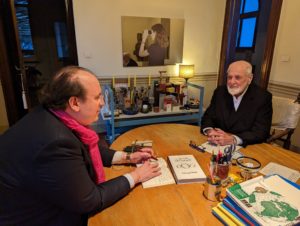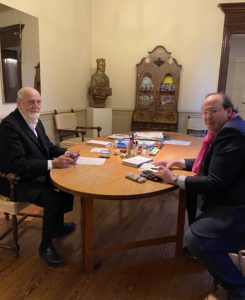From Cittadellarte to the Louvre, from the Louvre to Cittadellarte. An artistic bond that has developed over time, becoming increasingly close. On the one hand, the institution located in the spaces of the former Lanificio Trombetta in Biella, within an industrial archaeology complex, which, in addition to housing the richest collection of works by Michelangelo Pistoletto, is a creative workshop, a school, where ideas and projects lead to connecting art to every sphere of the social fabric, activating a responsible change in society at local and global levels; on the other, the former palace of the kings of France, the Empire and the Republic, between the Seine and the rue de Rivoli, the most prestigious museum in the world, first in terms of number of visitors, whose collection covers more than 5,000 years of history with over 700,000 objects and works of art. The cultural relationship was sealed with Pistoletto’s exhibition Année 1 – Le Paradis sur Terre (Year 1 – Paradise on Earth), held at the Louvre in 2013. This was followed last year by a shift from France to the United Arab Emirates, where for its 5th anniversary, the Louvre Abu Dhabi invited Michelangelo Pistoletto to exhibit a series of 11 mirror paintings inspired by the artist’s exhibition at the Louvre in Paris (full details can be found in our previous article). Here the artist took part in the Anniversary Talks: an exclusive series of live talks celebrating an important chapter in the history of the Abu Dhabi museum and its collection of artworks from around the world through the voices of specific partner institutions, artists and historians. One of the events featured Pistoletto, Nujoom Alghanem and Yan Pei Ming as speakers, and was moderated by Donatien Grau, advisor for contemporary programmes to the presidency of the Louvre and, previously, advisor to the presidency of the Musée d’Orsay. After years of an established collaborative relationship, last week Grau met Michelangelo Pistoletto at Cittadellarte to launch new projects: we propose, for the occasion, an interview with Grau.

Donatien, let us first define your role. What do you do at the Louvre?
I am the president’s advisor for contemporary programmes. My job is to work with President Laurence des Cars and the whole team on contemporary reinterpretations of the museum. The Louvre is not a place for contemporary art, it is a contemporary place for art: for these reasons it is necessary to reinterpret the collections, the museum, the history of the place and the mission. I cooperate with all departments to devise together new projects and new ways of reading the museum, without a fixed format. I want to stress that when I refer to artists, I do not only mean visual artists, but also philosophers, film makers and creatives of different languages. Paul Cézanne said that the Louvre is “the big book where we learn to read”: that is it, knowing how to read the Louvre is fundamental to the present itself and, with this in mind, we must offer different ways to make this process possible.
What parallels exist between the Louvre and Cittadellarte? Both institutions, with due proportion, host heterogeneous visitors from all over the world, and also have a deep connection with the social fabric of reference…
It is not really a question of heterogeneity, because it gives the idea of elements that are together, but in discordant forms; I consider ‘diversity’ and ‘plurality’ to be more appropriate terms, because they are different ways of being together, just as in the archipelago city of Cittadellarte. I think that the talk that Michelangelo Pistoletto gave at the Louvre Abu Dhabi on the subject last November, which I moderated, was particularly important. I refer specifically to the reading of an extract on the archipelago city from the artist’s new book, The Formula of Creation. I consider the vision of a place characterised by interconnected islands to be quite significant; the emergence of this theme proved even more significant in Abu Dhabi, which is in fact an archipelago. In general, I am fascinated by the dynamism of the principle of creation and the proximity of Pistoletto’s museum-like thinking. The way of reasoning of the artist and of Fondazione Pistoletto, which offers a glimpse into the future but at the same time into the past, is the dream of the Louvre, which brings together human history from the invention of writing to modernity. What emerges as the central element at Cittadellarte is essentiality, as well as the individual and collective creativity of the human being.
At Cittadellarte there is a deep connection between art and sustainability. With reference to this binomial, do you think the artist should feel a social responsibility?
Modern art is concerned and has to do with sustainability, also because, as Proust said, art is a way to live longer. Many, in fact, have become well known over time thanks to art. This is not enough: artists today must feel a responsibility because they live in the present and are part of the world. The contemporary life of artists is placed in a metaphorical mirror and for this reason it has become even more necessary to strive for sustainability, which has always been an element of art, today is simply more consciously present.

Michelangelo Pistoletto argues that museums should not remain crystallised in time, but live in the present. What, in your opinion, is the role of museums in contemporary society?
Museums have a very important political and social role. Where else do we find tens of thousands of people gathered in a single day? Perhaps in a church or a place of worship, in a stadium for a football match, at a rock star concert: in all these cases the individuals who gather for the occasion are part of a community; whereas the Louvre, where 30,000 people converge every day, is a place where the community is humanity. It is therefore not a community of interests, but of human beings. The Louvre’s visitors are of totally different origins, cultures and ages; for this reason, the museum is the only place where one goes to participate in the feeling of being human together. That is it, such a place, with this life, cannot but be part of the present. So, with reference to Pistoletto’s point made in the question, there are two possible ways forward: one is to say that contemporaneity is not of interest to the museum – but by saying that museums are not contemporary we are giving a contemporary point of view anyway –, the other is to realise that they are the present, that they exist in the present, also in the light of the 30,000 people who visit us every day, and to transform this feeling into a museum programme.
In light of your collaborations with Michelangelo Pistoletto, what has struck you most about the artist on an artistic and personal level?
The personality, the generosity and above all the energy and enthusiasm he injects into creating and thinking. For me, all this is fascinating and very inspiring. I also find it particularly significant that he has created works that are so diverse and that he always asks himself intimate and introspective questions to develop his artistic practice, constantly reinventing himself. Thus, he always demonstrates a sense of the power of art and creation. I also find the temporal dimension of the mirror paintings, which are of great impact and succeed in reflecting multiple points of view, to be particularly relevant.
What is art for Donatien Grau?
It is difficult to give a definition. I have always lived my relationship with art with and among artists, while my specialist training is ancient Roman numismatics. I think there are different ways of thinking about and experiencing art. Just think of Michelangelo Pistoletto and his relationship with Jackson Pollock and Piero della Francesca… between them there is diversity of language, but unity in the feeling of being in front of something metaphysical and at the same time human, that is, a form of creation. The beauty of art, perhaps, lies precisely in the fact that we cannot answer this question. I can say with certainty, however, that art is the creative mirror that humanity gives to itself.
Looking forward, what is in the future of art?
It is always complex to reflect on the future, especially for a historian, like me, who usually deals with the past and the present, – he laughs, – the future is always a transformation of existing elements: the process can be brutal or gentle, but the beauty of art, as of life, lies in the fact that you cannot know beforehand what will be there afterwards. Rather, one must concern oneself with the minds of the present in order to give possibilities to the works of the future.

